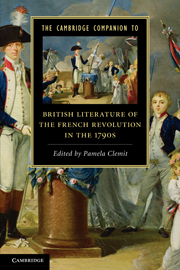Book contents
- Frontmatter
- 1 The Political Context
- 2 Burke, Reflections On The Revolution In France
- 3 Paine, rights Of Man
- 4 Burke And Paine: Contrasts
- 5 Wollstonecraft, vindications and historical And Moral View Of The French Revolution
- 6 Godwin, Political Justice
- 7 Wollstonecraft and Godwin: dialogues
- 8 Popular radical culture
- 9 Counter-revolutionary culture
- 10 Women’s voices
- 11 Novels of opinion
- 12 Revolutionary drama
- 13 Politics and poetry
- Guide to further reading
- Index
- The Cambridge Companions to...
9 - Counter-revolutionary culture
Published online by Cambridge University Press: 28 July 2011
- Frontmatter
- 1 The Political Context
- 2 Burke, Reflections On The Revolution In France
- 3 Paine, rights Of Man
- 4 Burke And Paine: Contrasts
- 5 Wollstonecraft, vindications and historical And Moral View Of The French Revolution
- 6 Godwin, Political Justice
- 7 Wollstonecraft and Godwin: dialogues
- 8 Popular radical culture
- 9 Counter-revolutionary culture
- 10 Women’s voices
- 11 Novels of opinion
- 12 Revolutionary drama
- 13 Politics and poetry
- Guide to further reading
- Index
- The Cambridge Companions to...
Summary
The early 1790s witnessed Britain's emergence as the leading counterrevolutionary power in an age of revolution, a position it held through the Napoleonic era and into the post-Waterloo restoration of legitimate continental regimes. The deployment of British troops against the threat of French republicanism abroad was accompanied by ideological mobilization at home, with profound consequences for literature and the arts as well as the press and public opinion. Yet scholars have not always looked closely at the way a conservative defence of the crown, the established church and the unreformed constitution shaped public expression. The fact that Romanticism has guided British literary studies in the period has itself narrowed the range of attention. The rubric for this volume, the 1790s, indicates a shift in conceptions of literary history. Yet to understand how counter-revolutionary culture has been overlooked it is worth setting out from the framework that Romanticism long provided.
In Romantics, Rebels, and Reactionaries, one of the few surveys to attend closely to conservatism, Marilyn Butler observed the way Romantic studies connected ‘changes in the arts of the 1790s with change in politics’, yielding the language of ‘Romantic Rebellion’ and ‘Romantic Revolution’. Challenging this reductive equation of political and aesthetic upheaval, Butler instead identified the preceding decades (1760 to 1790) with liberal developments in the arts, notably primitivism and neo-classicism, and then argued that after 1792 there was a ‘marked political reaction, towards a conscious conservatism, which in the next decade made itself felt deeply and decisively in the arts’.
- Type
- Chapter
- Information
- Publisher: Cambridge University PressPrint publication year: 2011



